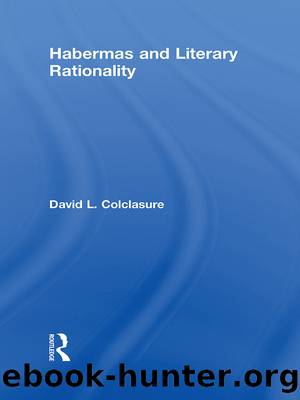Habermas and Literary Rationality by Colclasure David L.;

Author:Colclasure, David L.;
Language: eng
Format: epub
Tags: Humanities
Publisher: Taylor & Francis Group
Published: 2010-05-26T00:00:00+00:00
Wellmer notes that Adorno had also spoken of truth in art as an interference phenomenon, namely as (1) the interlocking of the mimetic moment with the rational; as well as in (2) the relation between truth, aesthetic appearance (Schein), and reconciliation.84 But because Adorno does not separate the two notions of truth discussed briefly above (objective truth and aesthetic coherence), his aesthetic theory remains an aesthetics of (objective) truth. For Adorno, art must be interpreted, its truth content must be (and can only be) presented, by the discursive practice of philosophy, that in turn cannot but raise truth claims about its object of inquiry, claims, however, which cannot capture the emphatic truth embodied in the artwork. Borrowing Koppeâs terminology, Wellmer argues that Adornoâs aesthetic theory is an âapophantic aesthetics of truth.â85 This is another way of saying, as Koppe had said, that Adorno sees truth in art as the embodiment of the emphatic form of assertory (propositional) truth.
Wellmerâs reconception of truth in art as an interference phenomenon between the three forms of validity allows the truth content of art to be described in terms of its truth-relevant âeffectsâ or world-disclosing potential.86 Up to this point in my discussion of Wellmer, the terms âtruth in artâ and âaesthetic validityâ have been used somewhat interchangeably, but the concepts they designate are clearly not identical in Wellmerâs account, because (propositional) truth constitutes only one of the three forms of validity, the interference of which makes up aesthetic validity. His distinction between truth and âtruth-relevant effectsâ is intended to give some contour to this distinction. In his analysis of the relation between truth in art and aesthetic validity, Wellmer holds that there is something about art that leads us to consider artworks to be bearers of truth. There is, in other words, something like a truth claim implicitly raised (and, at least implicitly, responded to) in the reception of an artwork. But this is not, strictly speaking, a claim of truth, but rather a claim of truth-potential, he argues.
Wellmer thus argues for aesthetic validity as a form separate from other forms of validity, one which consists in the coherence of a piece of art, which is in turn an indicator of its possible truth-effects. Wellmer understands this description of aesthetic validity as âtruth in artâ to represent a metaphorical use of the concept of truth. Moreover, Wellmer argues against the unmetaphorical use of the notion of truth in art:
Truth potential and truth claim of art can [â¦] both only be explained with recourse to the complex interdependence of the various dimensions of truth in the experience of oneâs life history or the formation and change of attitudes, manners of perception and interpretation. Truth thus be can attributed to art only metaphorically.87
Download
This site does not store any files on its server. We only index and link to content provided by other sites. Please contact the content providers to delete copyright contents if any and email us, we'll remove relevant links or contents immediately.
The European History Highway: A Guide to Internet Resources by Dennis A. Trinkle Scott A. Merriman(494)
The Seven Wonders of the Ancient World by Michael Denis Higgins(476)
European Security in a Global Context by Thierry Tardy(470)
European Security without the Soviet Union by Stuart Croft Phil Williams(469)
The Routledge companion to Christian ethics by D. Stephen Long Rebekah L. Miles(458)
Hudud Al-'Alam 'The Regions of the World' - a Persian Geography 372 A.H. (982 AD) by V. V. Minorsky & C. E. Bosworth(399)
Gorbachev And His Generals by William C. Green(391)
Get Real with Storytime by Julie Dietzel-Glair & Marianne Crandall Follis(390)
Tibetan Studies in Comparative Perspective by Chih-yu Shih Yu-Wen Chen(385)
Governance, Growth and Global Leadership by Espen Moe(381)
Hyperculture by Byung-Chul Han(377)
CliffsNotes on Fitzgerald's The Great Gatsby by Kate Maurer(360)
The Oxford History of the World by Fernández-Armesto Felipe;(354)
How Languages Are Learned 5th Edition by Patsy M Lightbown;Nina Spada; & Nina Spada(352)
The Egyptian Economy, 1952-2000 by Khalid Ikram(351)
Oral Poetry and Narratives from Central Arabia: The Poetry of Ad-Dindan : A Bedouin Bard in Southern Najd (Studies in Arabic Literature, Vol 17) (English and Arabic Edition) by P. M. Kupershoek P. Marcel Kurpershoek(343)
The Oxford Handbook of the Incas by Sonia Alconini(333)
Europe Contested by Harold James(319)
The Hutchinson Dictionary of Ancient and Medieval Warfare by Peter Connolly John Gillingham John Lazenby(305)
